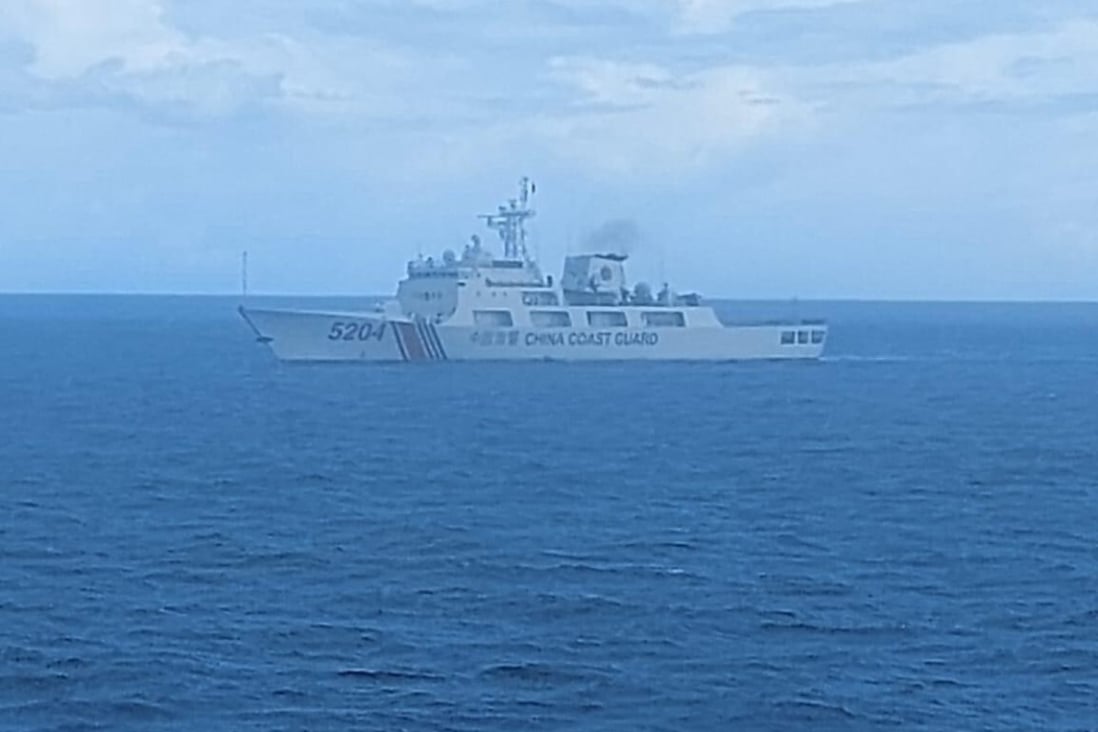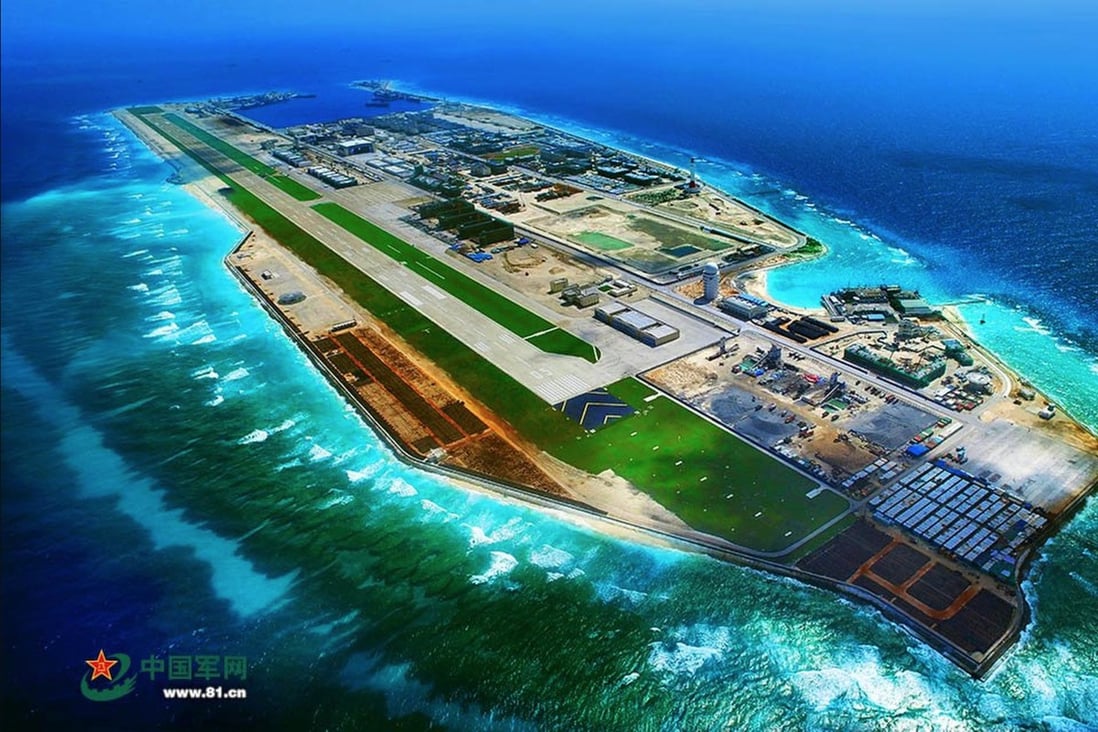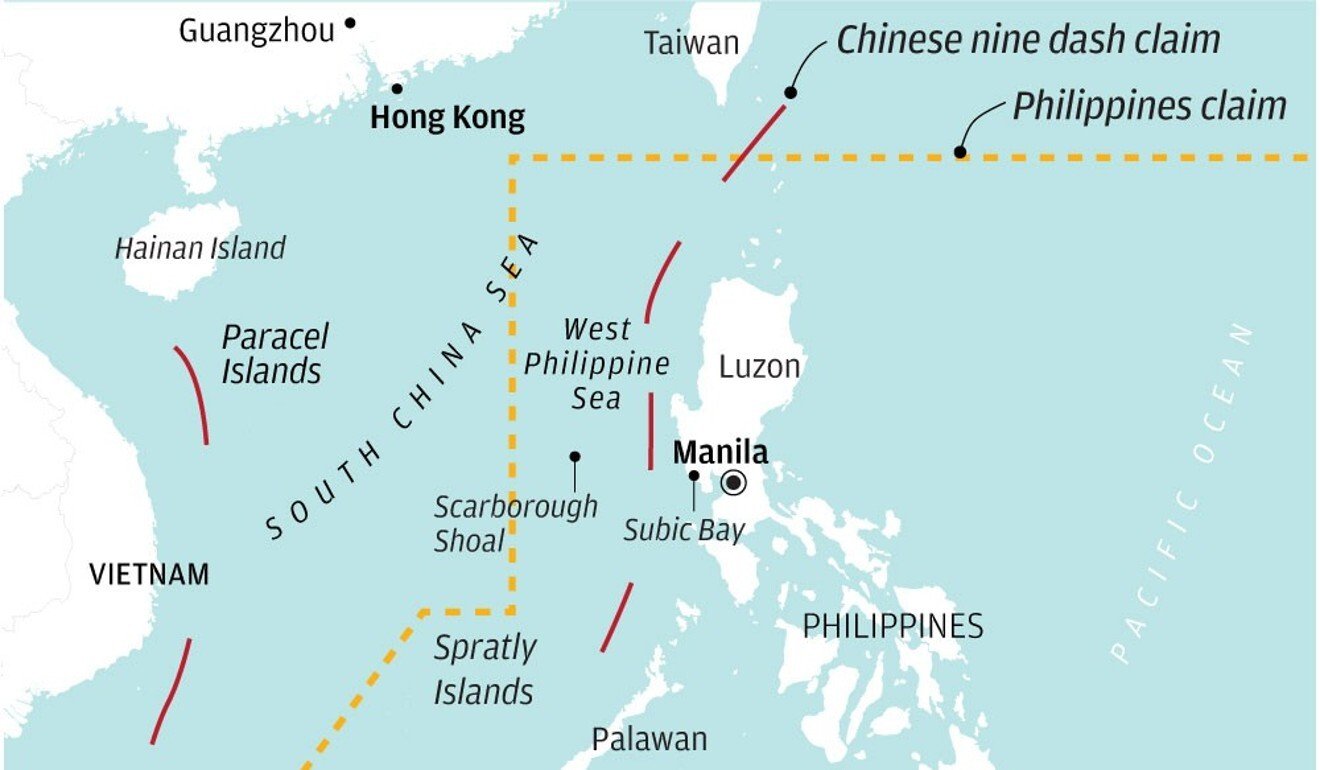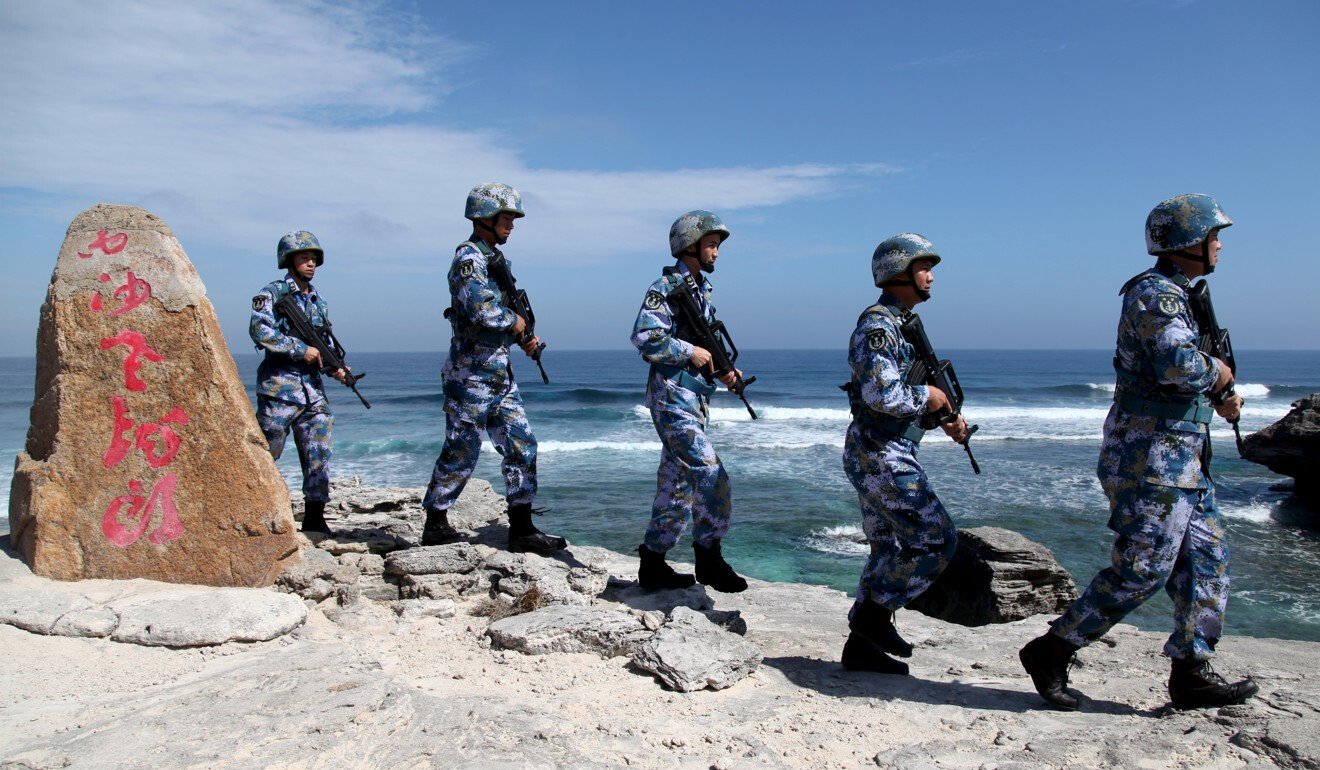China gives coastguards power to fire on foreign ships in disputed waters

23 Jan, 2021


A Chinese coastguard vessel in the waters around Indonesia’s Natuna Islands. Photo: Indonesian Maritime Security Agency
Die Streitkräfte sind nun befugt, in allen Gebieten, in denen China Hoheitsrechte beansprucht, “alle notwendigen Mittel” einzusetzen… China hat Spannungen mit seinen Nachbarn riskiert, nachdem es ein Gesetz verabschiedet hat, das seiner Küstenwache zum ersten Mal ausdrücklich erlaubt, auf fremde Schiffe zu schießen und Bauten in umstrittenen Gewässern zu zerstören.
Das Gesetz zur Küstenwache, das am Freitag von Chinas oberstem gesetzgebenden Organ, dem Ständigen Ausschuss des Nationalen Volkskongresses, verabschiedet wurde, kam zwei Jahre nachdem Chinas Militär 2018 die Kontrolle über die zuvor zivile maritime Behörde übernommen hatte.
Das Gesetz ermächtigt die Küstenwache, “alle notwendigen Mittel” einzusetzen, um Bedrohungen durch ausländische Schiffe in Gewässern “unter Chinas Gerichtsbarkeit” abzuwehren. Es wird der Küstenwache auch erlauben, Präventivschläge ohne Vorwarnung zu starten, wenn die Kommandanten dies für notwendig erachten.
Es ist unklar, ob das Gesetz auf alle von Peking beanspruchten Gewässer angewendet wird, das eine Reihe von konkurrierenden Ansprüchen mit seinen Nachbarn im Ost- und Südchinesischen Meer hat.
Japan weighs in on South China Sea dispute, adding to pressure on Beijing21 Jan 2021
Nach dem neuen Gesetz kann die Küstenwache in den von China beanspruchten Gewässern von anderen Ländern errichtete oder installierte Strukturen abreißen und ausländische Schiffe in dem Gebiet entern und inspizieren.

Die Verabschiedung des Gesetzes wird wahrscheinlich die Besorgnis unter Chinas Nachbarn über die Aussicht auf aggressivere Operationen verstärken.
Chinese coastguard ships have played a leading role in asserting China’s maritime claims, including in fishing disputes off Indonesia’s Natuna Islands and the stand-off with Vietnam over Vanguard Bank.In a document published last month, the US said it would integrate its coastguard into the naval forces countering China’s growing presence in the South China Sea.
Andere Anwärter im Südchinesischen Meer sind dabei, ihre Küstenwachen zu verstärken. So hat Vietnam ein Gesetz verabschiedet, das es seiner Küstenwache erlaubt, außerhalb der Hoheitsgewässer des Landes zu operieren.
Japanische Diplomaten haben bereits gegen die wachsende Präsenz chinesischer Küstenwachen in der Nähe der Diaoyu- oder Senkaku-Inseln im Ostchinesischen Meer protestiert.
Die Sprecherin des Außenministeriums, Hua Chunying, sagte am Freitag, dass das neue Gesetz die Funktionen und Befugnisse der Küstenwache klären würde und dass es im Einklang mit der internationalen Praxis sei. Hua fügte hinzu, dass China seine Differenzen mit Japan weiterhin durch Dialog verwalten werde.
Collin Koh, wissenschaftlicher Mitarbeiter an der S. Rajaratnam School of International Studies an der Nanyang Technological University in Singapur, sagte, die zweideutige Sprache des Gesetzes könne das Risiko einer Fehlkalkulation in den umstrittenen Gewässern erhöhen.
PLA troops in South China Sea learn ‘essential’ battlefield English18 Jan 2021
“Das bedeutet auch, dass das Gesetz … die Autorität verleiht, Gewalt anzuwenden, um diese Rechte gegen andere ausländische Parteien durchzusetzen, selbst wenn sie in deren legitimer [ausschließlicher Wirtschaftszone] operieren”, sagte er
“Generell bedeutet es eine Erhöhung des Risikos einer Fehlkalkulation und könnte möglicherweise sogar eine abschreckende Wirkung auf die Strafverfolgung anderer gegen chinesische Fischer haben.” Da dem Personal an vorderster Front die Befugnis eingeräumt wird, zu beurteilen, ob sie das Feuer eröffnen sollten, sagte Koh, dass die offene Natur der Bestimmungen “anfällig für Missbrauch sein könnte” und die Situation eskalieren könnte.
South China Sea: the dispute that could start a military conflict
China ist nur eines von mehreren Ländern, die die Souveränität über einen Teil des Seegebiets beanspruchen, in dem reiche Erdöl- und Erdgasvorkommen vermutet werden Das Meer steht im Mittelpunkt eines intensiven militärischen Interesses, wobei Peking Außenposten auf künstlichen Inseln errichtet und die US-Marine Patrouillen zur Wahrung der Seefreiheit durchführt
11 Aug, 2020

Chinas Verkehrsministerium eröffnete Anfang 2019 ein maritimes Rettungszentrum auf dem Fiery Cross Reef im Südchinesischen Meer. Das Südchinesische Meer ist eine der meistbefahrenen Wasserstraßen der Welt und reich an natürlichen Ressourcen. Es ist auch eines der am meisten umkämpften Seegebiete, in dem verschiedene Länder, darunter China, Vietnam und die Philippinen, Souveränität beanspruchen.The United States is not a claimant but it does have strategic interests in the area and its military conducts regular patrols.Tensions escalated in mid-July when, for the first time, the US formally opposed China’s claim to almost all of the waters, calling it “completely unlawful” under the international law of the sea.Analysts have warned that the dispute could be a tipping point for military conflict. The Chinese air force of the People’s Liberation Army has conducted live-fire drills in the area as recently as July in response to the US Navy’s own drills and freedom-of-navigation operations.But tensions have simmered for some time. Satellite images show that China has built artificial islands and military facilities in parts of the South China Sea, much to the opposition of other claimants.In 2016, an international tribunal in The Hague found that China violated the Philippines’ sovereign rights in the waters by interfering with fishing and oil exploration and building islands on marine features such as reefs.Chinese President Xi Jinping rejected the ruling and said China’s territorial sovereignty and maritime interests in the waters would not be affected.
What does China claim?
China, the Philippines, Vietnam, Malaysia, Brunei and Taiwan all claim part of the South China Sea, using various historical and geographic arguments as justifications.China claims a vast area of the sea within its “nine-dash line”, which stretches up to 2,000km (1,240 miles) from the Chinese mainland to waters close to Indonesia and Malaysia. China has erected military facilities and stationed troops on artificial islands it built in the area, although it insists its intentions are peaceful.

SCMP Graphics
Vietnam beansprucht die Souveränität über die Paracel- und Spratly-Inseln, während die Philippinen das Eigentum an der Spratly-Inselgruppe und der Scarborough Shoal geltend machen. Die Paracels sind in China als Xisha und in Vietnam als Hoang Sa bekannt, die Spratlys als Nansha.
Brunei und Malaysia beanspruchen die Souveränität über südliche Teile des Meeres und einige der Spratly-Inseln.
Die südostasiatischen Kläger sagen, dass die chinesische Grenze in ihre völkerrechtlich festgelegten Hoheitsgewässer eingreift, während Taiwan – von Peking als abtrünnige Provinz betrachtet – einen ähnlichen Anspruch wie das chinesische Festland hat.
Nach dem Seerechtsübereinkommen der Vereinten Nationen (Unclos) hat jedes Land das Recht, natürliche Ressourcen innerhalb seiner ausschließlichen Wirtschaftszone auszubeuten, die sich 200 Seemeilen (370 km) von der Küste entfernt erstreckt.
The South China Sea dispute explained
Why is the sea worth contesting?
The South China Sea is a key commercial thoroughfare connecting Asia with Europe and Africa, and is believed to have major reserves of natural gas and oil.
One-third of global shipping, or about US$3.37 trillion in international trade, passes through the South China Sea each year, including about 80 per cent of the oil imported by China, the world’s second-largest consumer of the resource.
The US Energy Information Administration estimates the area contains at least 11 billion barrels of oil and 190 trillion cubic feet of natural gas. Other estimates are as high as 22 billion barrels of oil and 290 trillion cubic feet of gas.
The disputed water also accounts for 10 per cent of fish caught globally, making it a key source of food for hundreds of millions of people.https://www.youtube.com/embed/IbmpAk0zrbM?rel=0&mute=1&playsinline=1&frameborder=0&autoplay=0&origin=https%3A%2F%2Fwww.scmp.com&embed_config=%7B%22relatedChannels%22%3A%5B%22UC4SUWizzKc1tptprBkWjX2Q%22%5D%2C%22adsConfig%22%3A%7B%22adTagParameters%22%3A%7B%22iu%22%3A%22%2F8134%2Fscmp%2Fweb%2Fchina_diplomacydefence%2Farticle%2Finstream1%22%7D%2C%22nonPersonalizedAd%22%3Atrue%7D%7D&enablejsapi=1&widgetid=2
Washington’s hardened position on Beijing’s claims in South China Sea heightens US-China tensions
Recent developments
Tensions have been rising in recent months, with other claimants and the US accusing China of worsening relations by increasing its infrastructure and military build-up in the area.
In mid-July, Washington said “Beijing’s claims to offshore resources across most of the South China Sea are completely unlawful” and threatened to sanction Chinese officials and companies that pursued “illegal” claims in the contested waters.
The US has stepped up its military presence, sending in warships and aircraft to keep tabs on China’s activities.
Although the US does not officially align with any of the claimants, it has wide-ranging security commitments in East Asia, and is allied with several countries bordering the sea, including the Philippines, Singapore and Vietnam.

People’s Liberation Army Navy soldiers patrol Woody Island, in the Paracels Archipelago. Photo: Reuters
The sea is also a vital trade route in the global supply chain, used by American companies that make goods in the region.
The US has conducted freedom-of-navigation operations, designed to challenge what it considers excessive claims and grant the free passage of commercial ships in its waters.In 2019, US Navy vessels sailed nine times within 12 nautical miles of features claimed or occupied by China – the highest number of patrols since Beijing controversially began constructing artificial islands around disputed reefs in the waterway in 2014.
Is there progress on a resolution?
The Association of Southeast Asian Nations has been working with China on an official code of conduct to avoid clashes in the disputed waters. A binding agreement had been discussed for years to little avail but in November 2018 China said it hoped the consultation would be completed in three years.In 2013, the Philippines filed a case against China in the Permanent Court of Arbitration in The Hague based on Unclos.
The tribunal ruled in 2016 that Beijing had no historical rights to the waters within its nine-dash line. But China, which did not take part in the proceedings, refused to recognise the decision.
Southeast Asian nations have traditionally rejected looking for a bilateral solution with China, the region’s main economic and military power. Despite this, one year after the landmark ruling against China’s territorial claims, Philippine President Rodrigo Duterte agreed to resolve the dispute with China through bilateral talks.
In 2019, Vietnam said it could explore legal action to assert its maritime claim although it preferred to do so through negotiations.
From our archivehttps://www.youtube.com/smart_embed?channels=UC4SUWizzKc1tptprBkWjX2Q&enablejsapi=1&origin=https://www.scmp.com&playsinline=1&mute=1&block_videos=8eqtl0ym1p8,IbmpAk0zrbM&embed_config=%7B%22relatedChannels%22%3A%5B%22UC4SUWizzKc1tptprBkWjX2Q%22%5D%2C%22adsConfig%22%3A%7B%22adTagParameters%22%3A%7B%22iu%22%3A%22%2F8134%2Fscmp%2Fweb%2Fchina_diplomacydefence%2Farticle%2Finstream2%22%7D%2C%22nonPersonalizedAd%22%3Atrue%7D%7DChina threatens ‘forceful measures’ in response to US bill on Hong Kong rightsCONVERSATIONS (12)

Keine Kommentare:
Kommentar veröffentlichen